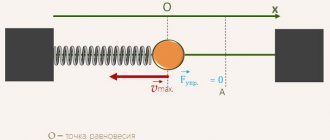Definition Body weight is the force with which the body, due to attraction to the Earth, presses on the support or stretches the suspension.
The weight of a body is of an electromagnetic nature (not to be confused with the force of gravity - it arises between two bodies and has a gravitational nature!). Denoted by P. Measured with a dynamometer. The unit of measurement is N (Newton).
The weight is in the opposite direction to the ground reaction force or string tension . The point of application of weight is the point of support or suspension: P↑↓N or P↑↓T.
According to Newton's III law, the modulus of body weight is determined by one of the following formulas:
P=T; P=N; P = Fcontrol
If the body and the support or suspension are stationary , then the moduli of the reaction force of the support, the tension force of the suspension, and the elastic force are equal to the modulus of gravity. Therefore, in a stationary system, the modulus of weight of a stationary body is also equal to the modulus of gravity:
P0 = F heavy = mg
If a body is in a state of weightlessness , its weight is zero: P = 0. This means that this body has no effect on either the suspension or the support.
Example No. 1. A weight weighing 1 pound stands on the floor. Determine the weight of the weight.
Since the weight is at rest, its weight will be equal to the modulus of gravity. 1 pood = 16.38 kg. Hence:
P = mg = 16.38∙10 = 163.8 (N)
Problems on weight and weightlessness with solutions
Task No. 1. Problem of calculating the weight of a body moving with acceleration
Condition
A load weighing 20 kg lies on the floor of an elevator, which moves upward with acceleration a=4 m/s^2. Find the body weight.
Solution
According to Newton's second law (in vector form and in projection onto the y-axis):
According to Newton's third law:
Answer: 280 Newtons
Task No. 2. Problem calculating the weight of a body in a liquid
Condition
A ball with a radius of 10 centimeters has a mass of 20 kilograms. How much will it weigh in water?
Solution
Weight of the ball in the air:
An Archimedes force acts on a body immersed in a liquid:
Answer: P=158 N.
Task No. 3. Finding the weight of a body with a known mass
Condition
The body weighs 400 Newtons. What is its mass?
Solution
Answer: 60 kg.
Task No. 4. Calculation of liquid weight
Condition
What is the weight of water that completely fills a liter bottle?
Solution
Knowing the volume of water and taking its density from the reference book, we calculate the mass of water:
Answer: P=10 N.
Task No. 5. Finding weight in free fall. Weightlessness on Earth
Condition
An elevator with a person breaks down in the shaft and falls freely until the safety system is activated. What is the weight of a person at the moment of falling?
Solution
The elevator and the person are moving with acceleration a=g. According to Newton's second and third laws, a person's weight in this case will be calculated by the formula:
In other words, the person does not act on the support in any way, so it falls at the same time as him. A typical example is when the weight is zero.
Answer: P=0 N.
By the way! For our readers there is a 10% on any type of work.
Weight in physics
Mass is a measure of the inertia of a body . The more inert a body is, the longer it will take to give it speed. Roughly speaking, the higher the mass value, the harder it is to move an object. In the International System of Units, mass is measured in kilograms. But it is also measured in other units, for example;
- ounce;
- lb;
- stone;
- US ton;
- English ton;
- gram;
- milligram and so on.
When we say one, two, three kilograms, we compare the mass with a reference mass (the prototype of which is in France in the BIPM). Mass is denoted by m.
Questions on the topic “weight and weightlessness”
Question 1. In what case is the weight of a body equal to the force of gravity acting on it?
Answer. Weight is equal to gravity if the body is at rest or moving uniformly and in a straight line (with zero acceleration).
Question 2. In what other cases can one experience a state of weightlessness?
Answer. The state of weightlessness is also achieved during free fall.
Question 3. Is long-term exposure to weightlessness harmful to health?
Answer. Prolonged stay in weightlessness entails adaptive changes in the cardiovascular and musculoskeletal systems. Therefore, upon arrival on Earth, astronauts need rehabilitation.
Question 4. Where will the weight of a 100-kilogram body be greater: on Earth, on Mars or on Saturn?
Answer. The weight of the body will be greater on Saturn, since the gravitational interaction is stronger there.
Question 5. What does body weight depend on?
Answer. Weight depends on the acceleration with which the body is moving, as well as the physical environment in which the body is located. For example, in water the weight will be less, since the Archimedes buoyancy force acts on the body, which partially compensates for the force of gravity.
We've all heard the word "overload." Overload is the opposite of weightlessness. This means that the body weight increases due to the accelerated movement of the support or suspension.
Video
This video lesson covers the topic of gravity and body weight.
Body weight ($overline
$) is the force with which a body acts on a support or suspension as a result of the body’s attraction to the Earth.
Therefore, as with any force, the newton is a unit of measurement for weight.
Newton's second law can be considered the fundamental law of classical dynamics. Its mathematical expression includes two quantities that cannot be expressed using kinematic parameters alone. These quantities are force ($overline$) and mass ($m$). These values are equally significant. Any of them can be considered basic. Having chosen a standard for the unit of one of them, they obtain a unit for the other using the basic law of the dynamics of translational motion. This way you can get two different systems of units, in one of them (metric) the basic units are mass units, and the units of force are considered derivatives. The reason for choosing mass units as the main ones is primarily that it is easier to create a standard for mass.
Units of weight in other unit systems
Sometimes in physics they use a system of units called CGS (centimeter, gram, second). In this system, the unit of length is centimeter (cm), the unit of mass is gram (g), and the unit of time is second (s). In the CGS system, the unit of weight, like any force, is called the dyne (symbol: din). 1 dyne is the force that imparts an acceleration to a body weighing 1 g equal to 1$frac<cm><s^2>$. The dyne is a very small unit of force compared to the newton. Newton and dyne are related as:
In technical calculations, you can come across another unit of measurement of weight, which is called kilogram - force (kgf). 1 kgf is the force with which the Earth acts on a reference mass of one kilogram, attracting it.
[1Happrox 0.10197162 kgf.]
In Russia, the kilogram-force is used as a non-systemic unit of measurement of force.
We get, din, kgf - units of weight.
The concept of "weight"
This term indicates how heavy an object is considered to be. That is why the concepts under consideration are often used as synonyms. However, from a technical point of view, weight is the force that a mass-containing object exerts on another body only under the influence of gravity. That's why it is measured in newtons.
Thus, this concept is used to estimate the amount of force that gravity produces on a body. It depends on the mass. The higher this parameter, the greater the gravity. On Earth it is approximately 9.8 newtons per 1 kilogram.
If we are talking about a person weighing 70 kilograms, his weight will be 70 * 9.8 = 686 newtons. For convenience, this force is estimated in kilograms.
On the Moon, where gravity is 6 times less than on Earth, a 70-kilogram astronaut will weigh 112 newtons. On Earth this corresponds to 11.2 kilograms.
Even on the ISS, where people are in a state of weightlessness, they have mass. Astronauts still need to push off walls and move around. The more they weigh, the more effort this will require.
Acceleration of gravity
The title of this paragraph of the article is the answer to the question of what the letter g means in physics. They use it because the Latin word for gravity is gravitas. Now it remains to understand what free fall acceleration is. To do this, consider what force acts on each body located near the surface of the Earth. Let the body have mass m, then we get:
F = G*m *M /R2 = m*g, where g = G*M/R2.
Here M, R are the mass and radius of our planet. Note that even if the body is at a certain height h above the surface, this height is much less than the value of R, so it can be ignored in the formula. Let's calculate the value of g:
g = G*M/R2 = 6.67*10-11*5.972*1024/(6371000)2 = 9.81 m/s2.
What does g mean in physics? Acceleration g is the amount by which the speed of absolutely any body falling freely on the surface of the Earth increases. From the calculations it follows that the increase in speed for each second of fall is 9.81 m/s (35.3 km/h).
Please note that the value of g does not depend on body mass. In reality, one can notice that denser bodies fall faster than less dense ones. This happens because they are acted upon by different forces of air resistance, and not by different forces of gravity.
The formula above allows us to determine g not only for our Earth, but also for any other planet. For example, if we substitute the mass and radius of Mars into it, we get a value of 3.7 m/s2, which is almost 2.7 times less than for Earth.
History of the concept
The concepts of heaviness and lightness as integral properties of physical bodies were mentioned by ancient Greek philosophers . Plato described weight as the natural tendency of objects to seek their own kind. For Aristotle, lightness was a property in restoring the order of the basic elements: air, earth, fire and water. Archimedes considered weight as the opposite of buoyancy. The first contact definition was given by Euclid, describing magnitude as the lightness of one thing compared to another, measured by balance.
When medieval scientists discovered that in practice, the speed of a falling object increased over time. They modified the concept of weight to preserve cause-and-effect relationships between phenomena. The concept was divided for bodies at rest and those in gravitational fall.
Significant results in the theory were achieved by Galileo, who came to the conclusion that a quantity is proportional to the amount of matter in an object, and not to the speed of its movement, as Aristotelian physics assumed. Newton's discovery of the law of universal gravitation led to the fundamental separation of weight from the fundamental property of objects associated with inertia. The scientist considered environmental factors and buoyancy to be a distortion of the measurement conditions. For such circumstances, he introduced the term apparent weight.
In the 20th century, Newton's concepts of absolute time and space were challenged by the work of Einstein. The theory of relativity placed all observers, moving and accelerating, in different conditions. This led to ambiguity as to what exactly was meant by mass, which, together with the gravitational force, became an essentially frame-dependent quantity.
The ambiguities generated by relativity have led to significant debate in the educational community about how to define weight for students and what it should be called. The choice began to lie between understanding it as a force caused by the gravity of the Earth, and the contact definition arising from the act of weighing.
What is mass?
Mass in physics is a scalar quantity. It determines the properties of a body in situations where its speed is significantly lower than the speed of light. The mass is divided into two types:
- gravitational – displays the force with which the body interacts with external gravitational fields, as well as what gravitational field the body itself creates;
- inert - shows the property of a body to remain at rest or move in a straight line in the absence of external influence.
International standard kilogram.
Cylinder made of an alloy of platinum (90%) and iridium (10%). Found at the International Bureau of Weights and Measures Mass determines how much of a substance is contained in an object and is expressed in kilograms. Numerically, it approximately corresponds to the weight of a body in kgf (kilogram-force), which is at rest at the earth's surface. In everyday situations, the words “weight” and “mass” are often used as synonyms, but they are not the same thing.
Interesting fact: often on food packages you can find two weight values - net and gross, which can cause difficulties. In fact, there is nothing complicated here, since the net weight shows how much the product weighs in its pure form, and the gross weight shows how much it weighs including packaging.
For example, if an astronaut’s weight on Earth is 80 kg, then in orbit it will be practically zero, on the Moon - about 15 kg, and on Jupiter - 200 kg. In this case, the mass remains the same in all situations.
Interesting: What is the fastest object after light? Photo and video
When measuring mass, the effects of various forces are not taken into account. It is calculated when the body is at rest and inertia. It is noteworthy that in medicine we usually have to deal with concepts such as “human weight,” although, in fact, we are talking about mass.
Newton is a unit of weight in the International System of Units
Currently, in physics, on a larger scale than others, they use the International System of Units (SI), in which the newton is a unit of measurement of weight, as a type of force. One newton (1N) is the force that imparts to a body having a mass of 1 kilogram an acceleration equal to 1 meter divided by a second squared in the direction of the force:
Newton is not a base unit in SI. With a unit such as the newton, multiple and submultiple units of force are used, using standard SI prefixes, for example: $1kN=<10>^3N;; 1nН=<10>^<-9>Н;; 1МН=<10>^6Н.$
And so, newton and $frac<kgcdot m><s^2>.$ are units of measurement of weight, like force in the SI system.
What is the difference between mass and weight?
Difference between mass and weight
The main differences between mass and weight are:
- Mass is a scalar, constant quantity, and weight is a vector quantity that changes depending on current conditions (in particular, gravity).
- Mass shows the amount of substance in a body. Weight is the force with which an object presses against a support.
- Mass is measured in kilograms. Weight is in newtons.
If you find an error, please select a piece of text and press Ctrl+Enter.
Gravity phenomenon
To understand what g means in physics (this topic is taught in the 7th grade of secondary schools), you should become familiar with the phenomenon of gravity. At the end of the 17th century, Isaac Newton published his famous scientific work, in which he formulated the basic principles of mechanics. In this work, he allocated a special place for the so-called law of universal gravitation. According to it, all bodies that have a finite mass are attracted to each other regardless of the distance between them. The force of attraction between bodies with masses m1, m2 is calculated using the following formula:
F = G*m1*m2/r2.
Here G is the universal gravitational constant, r is the distance between the centers of mass of bodies in space. The force F is called the gravitational interaction, which, like the Coulomb interaction, decreases with the square of the distance, but unlike the Coulomb interaction, gravity is only attractive.
Difference between mass and weight
The significant difference between these concepts is that the mass of an object remains constant, but the weight can change depending on conditions, for example, it can depend on the height from which the body falls down.
Also, in a state of weightlessness, the weight of objects can be equal to zero, while their mass is not zero at all and even each has its own.
Interestingly, due to the daily rotation of the Earth around its axis, a decrease in latitudinal weight is observed in some places.
Mathematical expression
In physics, the following formula is used for calculation:
m=ρ*V,
where V is the volume of the body.
This parameter is considered scalar, and this is where its main difference lies. The weight vector is always applied to the suspension or support and is directed straight down. Thus, this term is used to describe force. Various formulas are used to calculate this indicator.
If the determination of the parameter is carried out in a state of rest of the support, it is worth using this option:
Р=m*g,
where g is the acceleration due to gravity, which is 9.8 m/s2.
Nowadays
Nowadays people practically do not see the difference between mass and weight. A typical example of this is any purchase in a store where the buyer asks the seller for information about the weight of the product. From a scientific point of view, it would be correct to inquire about its mass. However, on the packaging the manufacturer indicates everything as needed.
We can see there such inscriptions as “net weight” (that is, the weight of the pure product) and “gross weight” (the weight of the product including packaging). As a result, mass and weight have become practically synonymous in the consumer sphere, and most people are genuinely surprised when someone tries to tell them that there is a difference in mass and weight.
Currently, there are no special requirements for each person to be able to distinguish between these concepts. Rather, it is more necessary for those engaged in scientific activities.
Source











